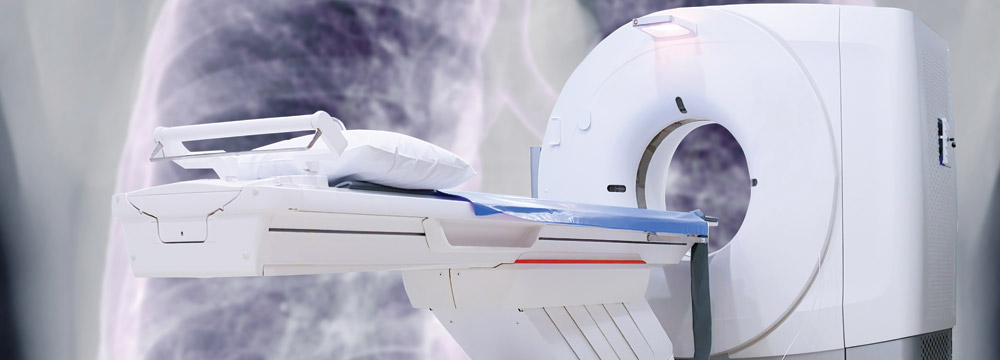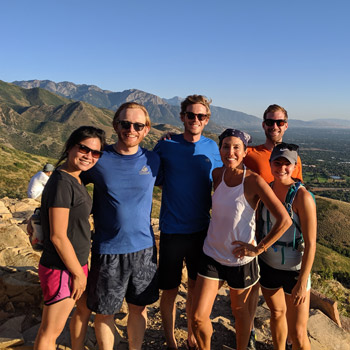
Lung screening's benefits, challenges
In March 2021, the U.S. Preventive Services Task Force (USPSTF) expanded eligibility for lung cancer screening by setting the benchmark at a 20 pack-year smoking history for those ages 50 to 80 years who are current smokers or former smokers who have quit within the past 15 years.
New criteria for lung cancer screening have widened the pool of eligible patients and may improve survival rates and decrease disparities. But the decision to begin annual low-dose computed tomography (CT) is not always a slam dunk, as physicians must communicate the possibility of detecting anxiety-producing lung nodules and other potential risks.
In March 2021, the U.S. Preventive Services Task Force (USPSTF) expanded eligibility for lung cancer screening by setting the benchmark at a 20 pack-year smoking history for those ages 50 to 80 years who are current smokers or former smokers who have quit within the past 15 years. The new criteria, which lower smoking history from 30 pack-years and the starting age from 55 years in the 2013 USPSTF recommendation, will boost the number of eligible adults by 87% overall, according to a modeling analysis commissioned by the Task Force and published with the recommendation in the March 9, 2021, JAMA. It also could reduce lung cancer deaths by 13% versus 9.8% previously, according to the modeling analysis. That translates to an additional 122 averted lung cancer deaths per 100,000 adults.
Even so, the individual decision to begin screening is not easy, said Robert J. Volk, PhD, the Hubert L. and Olive Stringer Distinguished Professor in Cancer Research at The University of Texas MD Anderson Cancer Center in Houston, who has studied decision making and lung screening. In a cross-sectional analysis of 2018 survey data published in 2019 by the American Journal of Preventive Medicine, just 14.4% of eligible adults living in one of 10 states had received a CT scan during the prior 12 months.
“We certainly don't want to scare people, but we want people to be aware of what they are getting into,” Dr. Volk said, noting that screening once started is an annual commitment. “This population by definition is a vulnerable group. These are individuals who have been smoking for many years, and they tend to have other health problems. It's important [for them] to know the implications of the choice. It's not benign.”
Changing eligibility
The Task Force changed the eligibility criteria for annual CT screening in large part because of findings from the Nederlands-Leuvens Longkanker Screenings Onderzoek (NELSON) trial, a large randomized study published in the New England Journal of Medicine in February 2020, which indicated that younger adults and those who smoked less could benefit from screening, said Michael Barry, MD, MACP, the Task Force's vice chair and a professor of medicine at Harvard Medical School in Boston. Prior to the 2013 Task Force recommendation, the National Lung Screening Trial (NLST) offered the only large randomized trial data available and included only those ages 55 to 74 years with at least a 30 pack-year history. In contrast, the NELSON trial also included adults who were younger than age 55 years and had smoked fewer than 30 pack-years, he said.
Expanding the eligibility criteria will also broaden access to more adults of all racial and ethnic backgrounds, with the modeling study predicting an increase in screening of 107% for Black adults and 112% for Hispanic adults. In addition, according to data from the American Lung Association, Black men are more likely to die of lung cancer than men from other racial or ethnic groups, and Black adults can also develop cancer at lower smoking rates than White adults. In one analysis, published in 2019 in JAMA Oncology, only 32% of Black current and former smokers with lung cancer met the USPSTF's 2013 criteria for screening compared with 56% of White adults, primarily due to the Black adults smoking less.
But the potential benefits of broader screening, per the modeling analysis, depend on current and former smokers getting a CT scan every year and following up on any nodules that have been identified. In the NLST, false-positive rates were 27.2% in the first year of screening and 15.9% in the second year, according to data published in the 2021 Task Force recommendation statement in JAMA. Among 1.7% of those adults screened, false-positive results led to biopsies and other procedures.
Improving access and buy-in to lung screening remains complex, particularly among diverse populations, according to a statement by the American Thoracic Society published Oct. 1, 2020, in the American Journal of Respiratory and Critical Care Medicine. It detailed numerous barriers, including lack of health insurance, clinician time constraints, insufficient health literacy to understand decision aids, and an inaccurate assessment of smoking history.
“Lung cancer screening is a process; it's not just ordering a CT scan,” said Kristina Crothers, MD, a coauthor on the statement and a professor of medicine in the division of pulmonary, critical care, and sleep medicine at the University of Washington School of Medicine in Seattle. To start, physicians must strive to identify more eligible adults, Dr. Crothers said. “Pack-years in particular are often not well documented.”
A medical assistant or another clinician in the practice can ask patients about their smoking habits, including clarifying the number of years, to get a more precise figure for the electronic health record, Dr. Crothers said. If the patient meets criteria, the physician could then be alerted before the visit, she said.
The annual physical might be the best time to capture smoking history, said Lionel S. Lim, MBBS, MPH, FACP, a geriatrician who practices at the VA Bedford Healthcare System in Massachusetts. Otherwise, it's possible for someone's eligibility to be missed amid more pressing medical issues, especially if the patient no longer smokes, he said.
“At least speaking for myself, it wasn't usual practice to pay so much attention to a former smoker's smoking history until recently, because of these new guidelines,” Dr. Lim said. “When someone is a nonsmoker, not actively smoking, we may not necessarily ask them, ‘So when did you quit? Or for how long or how much did you smoke?’”
Decision-making challenges
If a primary care physician does not have the assistance of a patient navigator or another clinician to help with shared decision-making, it might make more sense to provide information and context regarding lung cancer screening over several office visits, Dr. Crothers suggested. “That may be a lot to cram into one visit alone.”
One approach would be to ask the patient to review a decision-making tool prior to the visit, said Carmen E. Guerra, MD, FACP, an associate professor of medicine at the University of Pennsylvania's Perelman School of Medicine in Philadelphia, who has studied medical decision making. A good tool is the Should I Screen decision aid, created by the University of Michigan, as it calculates pack-years and lung cancer risk and is available in two other languages, including Spanish, she said.
Decision-making tools may introduce patients to the concept of false positives and other concerns that they may not have previously known about, Dr. Guerra said, and the physician can play an influential role by addressing related questions. If the patient declines screening, the physician can always revisit the subject at future visits, she said.
“I have had patients for example tell me, ‘No, No, No,’ on three different occasions in my office and on the fourth time they will say, ‘Yes,’” Dr. Guerra recounted. It may be that they had thought through their concerns, or perhaps knew someone who had been recently diagnosed with lung cancer, she said.
CMS previously required documentation of a shared decision-making conversation with a physician or other advanced practice clinician prior to a patient's first low-dose CT scan. But Dr. Volk noted that the latest coverage guidance, updated in early February, doesn't stipulate who must conduct that conversation, widening the options for physicians to train someone else in the practice to assume that role.
That does not mean that the physician should step back completely, Dr. Volk stressed. It's important that the physician assess whether the patient is healthy enough for screening, along with verifying that the patient would undergo surgery and other treatment if lung cancer were detected, he said. “You can't turn that over to a medical assistant.”
Walking patients through the lung screening options also may open the door to quitting tobacco, Dr. Guerra said. Once current smokers see their lung cancer risk spelled out by a decision aid, they can sometimes become motivated to quit, she said.
“Or they will say, ‘I really want to quit, but this is not the right time. I want to address it maybe at my next visit,’” Dr. Guerra said. In case they decide to attempt quitting before then, she will often offer a prescription for a smoking cessation medication to keep handy.
Promoting adherence
One challenge in assessing patient adherence is that there is no universal definition, said Yukiko Kunitomo, MD, a pulmonary and critical care medicine fellow at Johns Hopkins University in Baltimore and the first author on a meta-analysis of seven studies examining racial differences in adherence to lung cancer screening. The meta-analysis, published in the Jan. 1 CHEST, found an adherent follow-up rate of 37%. (Adherence was defined as follow-up for various reasons, not just a routine annual scan.) The study also found that Black adults were 33% less likely to follow up than White adults.
Dr. Volk coauthored another recent meta-analysis that looked at 15 studies and found that 55% of adults returned at least once for a routine annual scan. The adherence rate was lower among non-White adults and those who did not attend college, according to the findings, published Nov. 16, 2020, by JAMA Network Open.
Keeping patients on track is a steep task for primary care physicians to shoulder alone, said Dr. Volk, who recommends that physicians tap other clinicians and resources to assist. Patients must be mentally prepared that lung screening is not a one-time test and that there may be worrisome nodules through years of screening that do not turn out to be malignant, he said.
“So, it's an ongoing commitment on the part of the patient, an ongoing commitment on the part of the screening facility and the ordering provider that this is going to get done annually until the patient is no longer eligible,” Dr. Volk said. “We really need to build infrastructures around that to make that happens.”
Despite the challenges, there is already an encouraging trend toward earlier diagnoses. From 2006 to 2016, the percentage of lung cancers diagnosed at stages 1 and 2 increased from 26.5% to 31.2%, according to a study published Dec. 17, 2021, in JAMA Network Open. During that same period, deaths from lung cancer decreased about 4% each year, a trend that researchers at least partly credit to more screening.
Low-dose CT screening is still the new kid on the block compared with mammography and other cancer screening, Dr. Barry said. “It's going to take some time—this is relatively new evidence. But the stakes are high, and the benefits are there to be had,” he said. “We all need to work on getting as many people screened as possible, once they agree that it's a good idea for them.”



